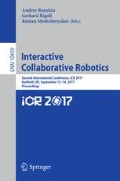Abstract
The experience of the ISS missions has demonstrated that it is necessary to examine the potential of using robots assistants for maintaining a habitability of the space station and for improving the quality of life of cosmonauts in lunar missions. New manned space missions will be marked by a decrease in crew support from Earth. These conditions call for the new forms of Human-Robot Interaction (HRI) in order to manage the workload of crew members in context of using robots for maintaining habitability of the manned space complexes. Correct setting of the daily schedule of robots activities in space missions will contribute to decrease the operational time of cosmonauts for routine manipulations, including Housekeeping manipulations, searching and preparing means for Next Day’s Work, transfer cargo, food preparation, elimination of waste and others works. An Augmentative and Alternative Communication (AAC) is a simple and clear variant of the HRI, designed to explain the meaning of the task for a robot. AAC is widely used for disabled persons with impairment in ability for communication skills, but in case of design HRI these techniques may be intended for the specification of tasks for robots on base of Ontology for Robotics. In accordance with AAC approach every schematic encodes for HRI may include the schedule time for job and its contents (or tools of necessity), as well as the conditions for initiating the activity or terminating it. This form of communication in the context of not-too-high intellectual capabilities of a robot (as a communication partner) may be considered as a practical approach in typical situations for fulfilling scenarios of daily activities in accordance with the 24-h schedules of the crew.
Access this chapter
Tax calculation will be finalised at checkout
Purchases are for personal use only
References
Bodkin, D.K., Escalera, P., Bocam, K.J.: A human lunar surface base and infrastructure solution, September 2006. doi:10.2514/6.2006-7336 (2006)
Falzon, P. (ed.): Cognitive Ergonomics: Understanding, Learning, and Designing Human-Computer Interaction. Academic Press, London (2015). 261 p.
Moroz, V.I., Huntress, V.T., Shevelev, I.L.: Planetnye ekspeditsii XX veka [Planetary expeditions of the XX century]. Space Res. 40(5), 451–481 (2002). (in Russian)
Frame-like structures DynSoft. http://www.dynsoft.ru/contacts.php
Karpov, A., Ronzhin, A.: Information enquiry kiosk with multimodal user interface. Pattern Recogn. Image Anal. 19(3), 546–558 (2009)
Kryuchkov, B.I., Usov, V.M.: The human-centered approach to the organization of joint activities of cosmonauts and an anthropomorphic robot-assistant on manned spacecrafts. Manned Spaceflight 3(5), 42–57 (2012). (in Russian)
Lakoff, G.: Cognitive modeling. In: Women, Fire and Dangerous Things. Language and Intelligence. pp. 143–184 (1996) (in Russian). Women, Fire, and Dangerous Things: What Categories Reveal About the Mind (trans: George, L.). University of Chicago Press, Chicago (1987). ISBN 0 226 46804 6
Minsky, M.: Frames for presentation of knowledge. Energiya, Moscow, 151 p. (1979) (in Russian). A Framework for Representing Knowledge (trans: Minsky, M.). MIT-AI Laboratory Memo 306, June 1974. Winston, P. (eds.) The Psychology of Computer Vision. McGraw-Hill, New York (1975, reprinted) (1974)
Petrenko, V.F.: Introduction to experimental psychosemantic: a study of forms of representation in ordinary consciousness, Moscow, 177 p. (1983) (in Russian)
Pospelov, G.S.: Preface. In: Minskiy, M. (ed.) Frames for Presentation of Knowledge. Energiya, Moscow 151 p. (1978) (1987, in Russian)
Yusupov, R., Kryuchkov, B., Karpov, A., Ronzhin, A., Usov, V.: Possibility of application of multimodal interfaces on a manned space complex to maintain communication between cosmonauts and a mobile robotic assistant. Manned Spaceflight 3(8), 23–34 (2013). (in Russian)
Kryuchkov, B.I., Karpov, A.A., Usov, V.M.: Promising approaches for the use of service robots in the domain of manned space exploration. SPIIRAS Proc. 32(1), 125–151 (2014). doi:10.15622/sp.32.9. (in Russian)
Acknowledgements
The research is partially supported by state research № 0073-2014-0005.
Author information
Authors and Affiliations
Corresponding author
Editor information
Editors and Affiliations
Rights and permissions
Copyright information
© 2017 Springer International Publishing AG
About this paper
Cite this paper
Kryuchkov, B., Syrkin, L., Usov, V., Ivanko, D., Ivanko, D. (2017). Using Augmentative and Alternative Communication for Human-Robot Interaction During Maintaining Habitability of a Lunar Base. In: Ronzhin, A., Rigoll, G., Meshcheryakov, R. (eds) Interactive Collaborative Robotics. ICR 2017. Lecture Notes in Computer Science(), vol 10459. Springer, Cham. https://doi.org/10.1007/978-3-319-66471-2_11
Download citation
DOI: https://doi.org/10.1007/978-3-319-66471-2_11
Published:
Publisher Name: Springer, Cham
Print ISBN: 978-3-319-66470-5
Online ISBN: 978-3-319-66471-2
eBook Packages: Computer ScienceComputer Science (R0)

